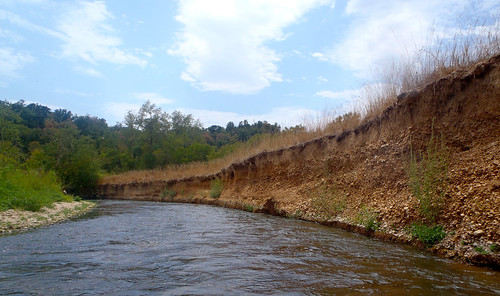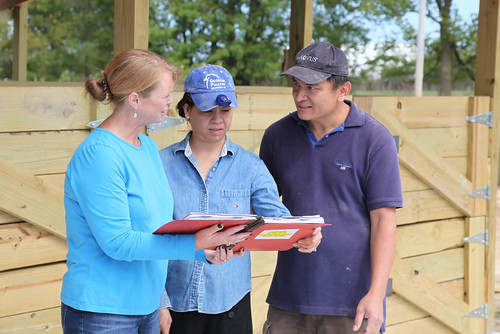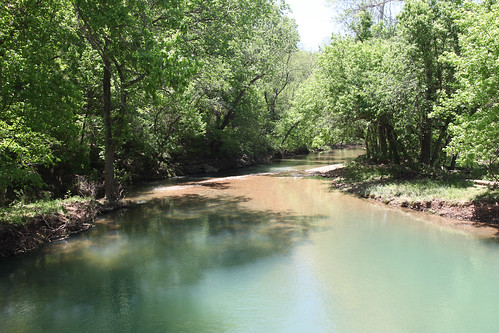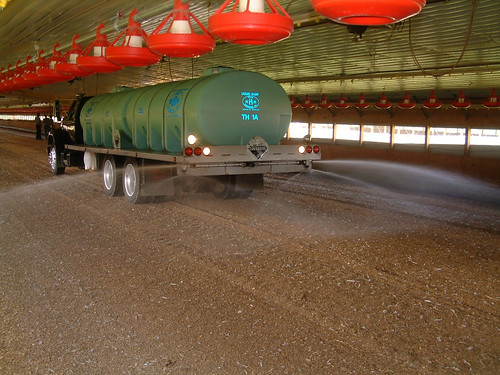
Erosion along the Illinois River and its tributaries results in high turbidity levels. (Photo by Lauren D. Ray)
Thanks to conservation partnerships, two segments of the Illinois River are off Arkansas’s impaired waters list.
Surface erosion and agricultural activities along the river caused high levels of turbidity – or water haziness. Because of these conditions ten segments of the river were added to the state’s list of impaired waters in 2014.
With assistance through the Natural Resources Conservation Service’s (NRCS) Illinois River Sub-Basin and Eucha-Spavinaw Lake Watershed Initiative (IRWI), poultry farmer Bruce Norindr is doing his part to improve water quality in the Lower Muddy Fork Watershed.
“When Mr. Norindr purchased his farm, the previous owner didn’t say he couldn’t use the existing stacking shed (used to store chicken litter) as a composter for chickens,” says Rhonda Foster, NRCS district conservationist in Washington County.

Rhonda Foster, Washington County, Ark., district conservationist, meets with Diem and Bruce Norindr on their poultry farm to discuss the operation’s nutrient management plan. (NRCS photo by Creston Shrum)
Funding through NRCS’ Environmental Quality Incentives Program (EQIP) and IRWI provided a solution – a 2,641-square-foot composting facility. The facility uses a mixture of raw organic by-products and chicken litter to dispose of chicken carcasses in an environmentally friendly way.
“This will definitely help my operation,” Norindr said, referring to the facility and technical assistance he received on the proper ratio of organic matter and litter.
Since the IRWI began in 2011, NRCS has funded nearly 550 contracts with private landowners, totaling more than $18 million, to apply conservation practices on more than 1.3 million acres in Arkansas and Oklahoma. Planting grasses, installing fencing that gives cattle access to waterways, using prescribed grazing practices, installing animal waste storage facilities, and implementing changes in agricultural waste treatment are examples of ways landowners like Norindr are helping clean up waterways.
“NRCS and our partners, such as the Arkansas Natural Resources Commission, Illinois River Watershed Partnership, the Washington and Benton county conservation districts and landowners in six sub-watersheds in the IRWI project area contributed to the delisting,” said Mike Sullivan, NRCS state conservationist in Arkansas.
Other IRWI partners include the Arkansas Department of Environmental Quality, Arkansas Game and Fish Commission, University of Arkansas Water Resource Center, University of Arkansas Cooperative Extension Service, and the Environmental Protection Agency.

Conservation practices installed along Spavinaw Creek are helping improve water quality in the Illinois River Sub-Basin. (NRCS photo by Creston Shrum)
With the help of a 2015 NRCS Regional Conservation Partnership Program (RCPP) project, work in the Illinois River Watershed will continue to improve water quality by reducing nutrient loads entering the watershed, improving soil health, decreasing soil erosion and improving energy efficiency and wildlife habitat.
Agriculture Secretary Tom Vilsack announced on Friday that the U.S. Department of Agriculture and other public and private partners are investing up to $720 million in new partner-led large scale, targeted RCPP projects to help communities improve water quality, combat drought, enhance soil health, support wildlife habitat and protect agricultural viability.
RCPP draws on local knowledge and networks to fuel conservation projects. Bringing together a wide variety of new partners including businesses, universities, non-profits and local and Tribal governments makes it possible to deliver innovative, landscape- and watershed-scale projects that improve natural resource concerns on working farms, ranches and forests.
“Agricultural producers know NRCS practices are based on sound science that helps them remain productive and competitive, while providing water quality and environmental protection,” said Delia Haak, executive director of IRWP. “We want to help agricultural producers be successful and assist them with the tools and knowledge they need to implement best management practices.”
NOTE: For an interactive look at USDA’s work in conservation and forestry over the course of this Administration, visit http://medium.com/usda-results.

Liquid alum is applied in a chicken house to reduce ammonia levels and bind phosphorus in chicken litter to improve air and water quality. (NRCS photo)
No comments:
Post a Comment
Note: Only a member of this blog may post a comment.